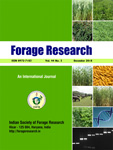GANGADHAR NANDA*
AICRP on Forage Crops and Utilization, Directorate of Research
Dr. Rajendra Prasad Central Agricultural University, Pusa-848125 (Bihar), India
*(e-mail: gnanda@rpcau.ac.in)
(Received: 7 May 2025; Accepted : 20 June 2025)
SUMMARY
A field experiment was conducted during the Kharif season of 2023 at Dr. Rajendra Prasad Central Agricultural University, Pusa, Bihar, India, to assess the productivity, profitability, and nitrogen use efficiency of forage maize genotypes under varying nitrogen levels. The study was laid out in a factorial randomized block design with three replications, involving seven maize genotypes and three nitrogen (N) levels (60, 100, and 140 kg N ha-1). Results revealed significant variation among genotypes and nitrogen levels for green fodder yield, crude protein yield, nitrogen use efficiency, and economic returns. The genotype FSM-2021-1 produced the highest green fodder and crude protein yields, while the application of 140 kg N ha-1 was most effective among N treatments. The highest partial factor productivity of nitrogen (PFPN) was recorded in genotype J-1006 (104.7 kg DF kg-1 N) and under the 60 kg N ha-1 treatment (114.2 kg DF kg-1 N). Economic analysis indicated that FSM-2021-1 achieved the highest net return (Rs. 55,479 ha-1) and benefit-cost ratio (2.86), followed closely by the 140 kg N ha-1 treatment (Rs. 56,003 ha-1 and B:C ratio of 2.86). The study highlights the potential of selecting suitable genotypes and optimizing nitrogen application to enhance forage maize productivity and profitability.
Key words: Forage maize, genotype, nitrogen application, nitrogen use efficiency, green fodder

